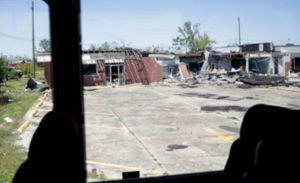Real estate market picking up

The remnants of a home In Mexico Beach, FL still clinging to its foundation, October 14, 2018 (Source: AIR Worldwide)
Now that Hurricane Michael has been upgraded to a Category 5 storm – only the fourth on record – Governor DeSantis is asking the President to increase the federal cost sharing of recovery from 75% to 90%. Meanwhile, Florida is keeping pressure on Congress to pass a long-delayed multi-billion relief bill, as new federal money is made available to put displaced Panhandle residents to work in the cleanup.
Governor DeSantis sent a letter to the President asking for the additional cost sharing money given the tremendous damage (estimated insured losses of $11 billion and estimated total losses of $25 billion) and the 72 million tons of debris left from Michael – most of which still needs to be cleaned-up. The President has the authority to issue a waiver and increase the federal cost share for hurricane recovery from the standard 75% to 90%. The President’s previous decision to pick up 100% of the costs for the first 45 days after the hurricane has saved the state and Panhandle communities nearly $500 million.
Meanwhile, $5.8 million in federal money has been awarded to help put to work those residents who were temporarily or permanently laid off because of the storm, as well as the self-employed and long-term unemployed. This disaster relief employment portal includes humanitarian assistance for storm victims and temporary jobs that can include demolition, clean-up, repair, renovation and reconstruction of damaged structures and public facilities. There’s certainly a tremendous need for that, with unemployment in Bay and Gulf Counties at 5% and 6.2% respectively, compared to Florida’s 3.5% rate.
The Governor’s bipartisan cabinet collectively upped its pressure on Congress last week, demanding Washington lawmakers pass a $13.5 billion relief package for Florida and other disaster-impacted states that they’ve been bickering over most of the six months since Michael struck. The Attorney General, Agriculture Commissioner, and CFO sent letters, complaining, in part, that “partisan politics and self-interest have obstructed federal disaster recovering funding, especially given the magnitude of the destruction.”

The view outside the tour bus window of Panhandle devastation, April 24, 2019 (Courtesy Florida Chamber Foundation)
In the Florida Legislature, leadership was still debating into this weekend how much they can allocate toward disaster recovery in the new fiscal year budget beginning July 1. (See Bill Watch for complete details.)
Business leaders from across the state last week took a two-day tour through some of the worst areas of damage, remarking on how parts looked like something out of a third world country and admiring the resiliency of the good people of the Panhandle. For some, it was their first time seeing the damage. They heard stories of all the people who don’t have homes and the agricultural workers who are poor and don’t have money to repair the damage, while they try to meet their existing obligations. As we’ve said here before, you just can’t appreciate the damage until you’ve seen it in person. PIC of tour
The private competitive marketplace is also contributing to the recovery. Home sales in Bay County, home to some of the worst damage, are up nearly 25% in the first quarter of this year, driven largely by investors looking for good deals in damaged homes. The median price was $215,000 – about the same price it was at the same time last year. Some homes are being bought out of necessity to be fixed up and used as housing for repair crews.
LMA Newsletter of 4-29-19

